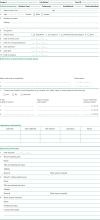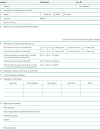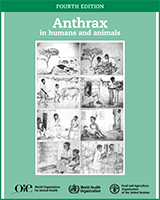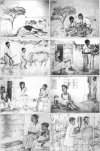All rights reserved. Publications of the World Health Organization can be obtained from WHO Press, World Health Organization, 20 Avenue Appia, 1211 Geneva 27, Switzerland (tel.: +41 22 791 3264; fax: +41 22 791 4857; e-mail: tni.ohw@sredrokoob). Requests for permission to reproduce or translate WHO publications – whether for sale or for noncommercial distribution – should be addressed to WHO Press, at the above address (fax: +41 22 791 4806; e-mail: tni.ohw@snoissimrep).
NCBI Bookshelf. A service of the National Library of Medicine, National Institutes of Health.
Anthrax in Humans and Animals. 4th edition. Geneva: World Health Organization; 2008.
9.1. Introduction
9.1.1. Understanding the concept of surveillance
Surveillance is the collection, collation and analysis of health data that enables the prompt dissemination of the information to those who need to know, in order that appropriate action may be taken. Effective surveillance is essential to any prevention and control programme and encompasses the mechanisms for disease detection, confirmation of diagnosis, reporting, collation of data and reporting back of the data to the source. Detection of rare diseases requires well-trained veterinary or human health-care providers. Confirmation of reports of suspicious cases requires appropriate laboratory support. Reporting requires mechanisms for easy communication of cases, and also some incentives for reporting or disincentives for not reporting. Many countries rely on disincentives for not reporting diseases under surveillance (reportable diseases). Regulations exist for reporting certain diseases (usually of high epidemic potential or with high morbidity or mortality rates) in most countries of the world.
Because of its epidemic potential, associated high morbidity and mortality rates, wide-ranging occurrence, and history of threatened use – and now actual use in the 2001 anthrax letter events – as a biological terrorist weapon, anthrax in humans or animals should be included on all national notifiable-disease lists.
Surveillance systems vary widely in objectives and methodology. The surveillance scheme outlined below may be adapted to accommodate the local veterinary and public health systems within a country. It should be noted that efforts to improve certain attributes of surveillance, such as specificity, may detract from other attributes such as timeliness.
9.1.2. Intersectoral cooperation
As with most zoonotic diseases where animals serve as the primary sources of human infection and epidemics (as opposed to zoonoses, where both humans and animals may be infected from common environmental sources), control of anthrax among humans depends on the integration of veterinary and human health surveillance and control programmes. Routine cross-notification between the veterinary and human health surveillance systems should be part of any zoonotic disease prevention and control programme, and close collaboration between the two sectors is particularly important during epidemiological and outbreak investigations.
High-risk areas for human disease may be identified pre-emptively by review of veterinary surveillance information by veterinary or public health authorities. Because herbivorous livestock and wild animals are more susceptible to B. anthracis than humans, and because in general soil sources do not represent a threat to humans directly, the potential threat to human populations is through contaminated animal products. The exceptions to this rule are biological warfare or terrorism, or laboratory settings where the spores of B. anthracis may be manipulated and concentrated in an unnatural way to represent a direct threat to human health through respiratory, gastrointestinal or cutaneous exposure – see also section 4.2.3. However, many countries rely on detection of human disease as the alert of anthrax epizootic activity. In these cases, humans may be considered sentinels (see also section 4.1). Ideally, this should not be the case, and enzootic and epizootic surveillance and reporting should lead to the implementation of anthrax control strategies that prevent human cases altogether. Realistically however, in many countries the support and infrastructure for human health surveillance programmes is greater than for veterinary equivalents. In such cases, when detection depends on the appearance of a human case, the control of anthrax among livestock is delayed and the losses suffered by farmers will be greater than if a functional veterinary surveillance programme is in place. This is because only a fraction of the livestock cases are ever identified and the disease goes unreported and uncontrolled.
9.2. Objectives
The design of a surveillance system for anthrax depends in part on its objectives. The primary objectives of any anthrax surveillance system are to prevent or reduce livestock losses and to prevent human disease. To achieve these objectives, the surveillance system should emphasize education of the producers and front-line veterinarians in the detection, confirmation and reporting of cases. This detection, confirmation and reporting should be followed by a strong response from the veterinary health system to control the disease. Prevention of cases among livestock depends on knowledge of enzootic regions and on vaccination of livestock in those affected areas. Gaining knowledge of risk areas is a secondary objective of surveillance for the disease.
Identification of the characteristics of the disease in the affected populations, and evaluation of prevention and control activities by monitoring the incidence of the disease in both animal and human populations, should be among other objectives chosen by the national surveillance programme.
9.3. Surveillance reporting outline
9.3.1. Local level
Animal and human health-care professionals, with their supporting laboratories, form the front line of any zoonotic disease surveillance system. Surveillance begins with the first point of contact by a veterinarian or clinician in the event of a suspicious case. In an optimal situation, concern over a suspicious case should result in either contact with local health authorities (veterinary or human) or the initiation of a case-reporting form.
Depending on the objectives of the surveillance system, a case form should be completed on every suspected or confirmed case. Depending on veterinary or public health resources, this case-report form may be completed by the local health-care professionals attending the suspicious case, or preferably by health authorities at the local level (municipal or county).
Figs 11&12 are examples of human and veterinary case-report forms. Minimum data elements for human case-reporting are:

Fig. 11
Sample anthrax case-report form (human).

Fig. 12
Sample anthrax case-report form (animal).
- case classification (e.g. suspected or confirmed);
- clinical form of the case (cutaneous, gastrointestinal, inhalational, meningeal);
- identifying information, and a unique identification code.
Depending on the objectives of the surveillance system, other pertinent data might include age, sex, geographical information, occupation, date of presentation, exposure history, nationality, date of clinical onset, treatment and outcome.
The local level (health-care centre, private clinic and physician, and other health personnel) is the first point of official contact with the infected patient and the point at which surveillance data should first be collected. Suspected rather than confirmed cases may be reported from this level to higher levels. The tasks at this level are diagnosis and case management, including treatment and health education plus, resources permitting, case and outbreak investigation. The laboratory criteria for the confirmation of any suspicious case may be included on the same case-report form, or the form may be simplified to only include whether the case was confirmed or not. Local health authorities may be asked to assist in diagnosis and case management.
Local health authorities are responsible for reporting to the intermediate level (i.e. state) or to the central level (i.e. federal), depending on the government structure. Also, local health authorities will be expected to mount the early epidemiological investigation targeted at:
- identifying and controlling the source of infection (including additional case-finding, case-confirmation, identification of source of infection and tracing sources of infection from infected animals or animal products);
- reducing population morbidity and mortality through initiation of control measures depending on the authority, epidemiological situation and guidelines.
Control measures for anthrax in livestock are given in chapter 8 and Annex 4. Depending on the epidemiological details of any human outbreak, control measures for humans are based on removal of the source of infection from human contact or separation of human populations from the infectious source(s); however, these control measures may vary widely in detail and will depend on the particular exposure situation.
9.3.2. Intermediate level
Depending on the political infrastructure, data from the report forms may be managed at an intermediate level such as a state health or veterinary department. Here the data may be collated and analysed for feedback to the local (municipal or county) level. Usually, the intermediate level collates and analyses data from local levels. In addition, personnel at this intermediate level may serve as support to the local level. The tasks of the intermediate level are:
- aspects of case-confirmation and case-management that cannot be undertaken at the local level;
- analysis of data from local levels;
- epidemiological investigations, tracing sources of infection from infected animals or animal products;
- initiation and monitoring of control measures.
9.3.3. Central level
Reporting of cases should also be transmitted to the central level. Depending on national resources, the central level will analyse and report the data back to the intermediate and local levels. In addition, the central level may formulate national policies and allocate resources based on the surveillance information. The central level may also provide technical support (e.g. laboratory or epidemiological) to the intermediate and local levels as appropriate, and it is responsible for reporting summary surveillance information to international authorities such as WHO and OIE.
9.4. Human surveillance
9.4.1. Case definition
Details of the clinical presentation of anthrax in humans can be found in chapter 4.
The suggested case definitions below may need to be adapted to local needs and laboratory capabilities available for confirmation of diagnosis (WHO, 1997b).
9.4.1.1. Clinical criteria
Anthrax is an illness with acute onset characterized by several clinical forms as described in detail in chapter 4, especially when supported by a suggestive case history. These could be summarized in a concise case definition for surveillance purposes as follows.
Localized form
Cutaneous. Skin lesion evolving over 2–6 days from a papular through a vesicular stage, to a depressed black eschar invariably accompanied by oedema that may be mild to extensive.
Systemic forms
Gastrointestinal. Abdominal distress characterized by nausea, vomiting, anorexia and followed by fever.
Pulmonary (inhalation). Brief prodrome resembling acute viral respiratory illness, followed by rapid onset of hypoxia, dyspnoea and high temperature, with X-ray evidence of mediastinal widening.
Meningeal. Acute onset of high fever possibly with convulsions and loss of consciousness, meningeal signs and symptoms.
9.4.1.2. Laboratory criteria
Several laboratory assays may be considered as supportive diagnostic criteria. The availability or reliability of these assays may vary from location to location, and therefore the definition of confirmed and suspected may be modified according to local laboratory capacity. However, it is thought that every country should be able to establish the necessary capabilities within the guidelines given in Annex 1 and meet the following laboratory criteria for diagnosis of anthrax:
- isolation and confirmation of B. anthracis from a clinical specimen collected from an affected tissue or site; or
- other supportive laboratory tests, including:
- —
evidence in fresh tissue or blood samples with traditional M’Fadyean (polychrome methylene blue) stained smears;
- —
evidence of B. anthracis DNA by PCR from specimens collected from an affected tissue or site;
- —
demonstration of B. anthracis in a clinical specimen by immunohistochemical staining; or
- —
other laboratory tests (e.g. serology).
9.4.2. Case classification
9.4.2.1. Confirmed case
A confirmed case of anthrax in a human can be defined as a clinically compatible case of cutaneous, inhalational or gastrointestinal illness that is laboratory-confirmed by:
- isolation of B. anthracis from an affected tissue or site; or
- other laboratory evidence of B. anthracis infection based on at least two supportive laboratory tests.
Note: it may not be possible to demonstrate B. anthracis in clinical specimens if the patient has been treated with antimicrobial agents.
9.4.2.2. Suspected case
A suspected case of anthrax in a human may be defined as:
- a clinically-compatible case of illness without isolation of B. anthracis and no alternative diagnosis, but with laboratory evidence of B. anthracis by one supportive laboratory test; or
- a clinically-compatible case of anthrax epidemiologically linked to a confirmed environmental exposure (infected animal product, contaminated fomite, or other source).
9.4.3. Special considerations for human surveillance
A single case of anthrax in a human population should result in a report and investigation.
Because the disease is rare in many countries, continuing education programmes for health-care providers should include information on recognition and confirmation of this disease.
Certain at-risk populations may warrant active surveillance (the implementation of case-finding activities among a subpopulation) on a regular basis. One example of such a need was found among hair and wool industry workers in Europe and the United States in the 20th century. Because of an especially high risk, these workers were more intensively observed for anthrax than the general population by the occupational health systems and authorities serving these groups.
9.5. Veterinary surveillance
9.5.1. Case definitions
9.5.1.1. Clinical description
Please refer also to the OIE Code for general guidance for animal health surveillance.1
Details of the clinical presentation of anthrax in animals can be found in chapter 3. In general in non-immunized cattle, sheep or goats, anthrax is usually a peracute disease characterized by septicaemia and sudden death, frequently (but not universally) with bleeding from orifices and subcutaneous haemorrhages. Other reported symptoms in cattle, horses, sheep and some wild herbivores consist of fever, dyspnoea, agitation and convulsions followed by death. In pigs, carnivores and primates, the main symptoms are local oedema and swelling of the face and neck. Failure of the blood to clot, absence of rigor mortis and the presence of splenomegaly are the most important necropsy findings (but not necessarily pathognomonic). (See also sections 3.4 and 3.5.)
9.5.1.2. Laboratory criteria for diagnosis
Internationally recognized standard diagnostic techniques and their interpretation for diagnosis of anthrax in animals are described in section 3.5 and Annex 1, as well as in the Manual of standards for diagnostic tests and vaccine (OIE, 2008).
9.5.2. Case classification
9.5.2.1. Suspected
A suspected case is a case that is compatible with the clinical description. In enzootic areas all sudden deaths should be regarded as suspected anthrax cases.
9.5.2.2. Confirmed
A confirmed case is a suspected case that is laboratory-confirmed. A diagnosis based on clinical signs may be difficult, especially when the disease occurs in a new area, and a confirmatory laboratory examination should be carried out as described in section 3.5 and Annex 1.
9.5.3. Special considerations for veterinary surveillance
- In countries or areas free of anthrax, the disease is treated as an exotic or foreign disease, and measures to be adopted are based on primary prevention, mainly the control of imported animals and animal products (see Annex 4).
- In enzootic countries or areas, whether or not animal vaccination is carried out, all suspected sudden deaths in animals should be investigated as possible cases of anthrax. Flocks or herds in direct or indirect contact with positive human cases should be investigated, as the human infection will have derived from animal cases and any infected herds or flocks should be identified and vaccinated. The primary prevention measures mentioned above should also be in place. In enzootic countries or areas where animal vaccination has been discontinued, particular emphasis should be placed on continued surveillance.
- Because the numbers of animals may be very large on individual affected properties, the unit of reporting may in some cases be the property or farm rather than the animal.
- Whenever possible, global positioning data should be included in case-reporting to ensure that affected areas are properly located and recorded.
In general, the occurrence and reporting of anthrax may cause economic harm to affected animal producers. For that reason, it is important that national programmes for anthrax control include no penalties for reporting and compensation for additional costs to the farmer. Anything that discourages reporting should be avoided, and everything that encourages reporting should be embraced. Suggested approaches to ensuring this are:
- Compensation to the owner should be available for any carcass proven (i) to be a case of anthrax, and (ii) to have been incinerated or disposed of by another officially approved method. Ideally, disposal of the carcass should be carried out by the official veterinary service.
- The initial vaccination of the herd or flock should be carried out by the official veterinary service.
- Quarantine should be kept as non-onerous as possible; it need not be longer than 21 days after vaccination of the affected herd has been carried out (see section 7.2.1.2); or, if cases continue to occur after vaccination, 20 days after the last case, according to the OIE-designated period (Annex 4).
- Animal health officers should be properly equipped with specimen-collection materials, equipment and materials necessary for disinfection, cleanup and disposal, and with antibiotics and vaccine plus syringes and needles. They should also be appropriately trained (e.g. not to administer vaccine and antibiotics simultaneously – see section 7.2.1.3) and, furthermore, should have the necessary transport and suitable office support for reporting cases.
- The laboratory technician should be supplied with the appropriate equipment, materials and training for confirmation of diagnosis.
- Appropriate educational literature for all persons involved, from the farmer/owner to ministry levels, and information packets for the media should be produced.
- Every effort should be made to get local understanding and popular support for the policy of carcass destruction and herd vaccination.
- The reporting system should be based more on incentives than penalties, although penalties for failure to report may be necessary. The reporting should not incur cost (e.g. forms, postage, etc.) to those required to make reports.
- Treatment and vaccination of the remainder of the herd/flock and the services of the animal health officers in assisting with cleaning and disinfection should be free of charge.
- Affected herds/flocks should be revaccinated annually for three years (sections 8.8, 8.9).
9.6. Communication of disease data
Maps offer an efficient tool for communicating data on the prevalence of diseases or the location of at-risk populations. In order to facilitate disease control and surveillance, WHO has developed the HealthMapper. This software is specifically designed for use by public health administrators working at national and district levels. The HealthMapper simplifies the collection, storage, updating, retrieval and analysis of public health data. Core to the HealthMapper is the geographical database. This database contains the standardized data of individual countries with regard to various features such as administrative boundaries, population by administrative level, roads, rivers, forests and elevation. Such data enable the linkage of disease data such as cases per district with background data such as population size or environmental factors. Furthermore, standardized data facilitate the assessment of trends over time and the comparison of disease prevalence across geographical areas. The geographical database is developed and updated in collaboration with national ministries of each partner country. The completeness of these data varies from country to country. The HealthMapper geographical files may be used in conjunction with ESRI Inc. products.
In addition to the HealthMapper, WHO has launched the Global Health Atlas. This is more suitable for comparisons across countries than within countries. The Global Health Atlas is an electronic platform that builds on the HealthMapper and brings together standardized databases on infectious diseases and on core health statistics. The Global Health Atlas contains data on demography, environmental factors, socioeconomic conditions and health indicators.2
9.7. Templates for control programmes from the Model Country Project
In the third edition of these guidelines (Turnbull et al., 1998a), Appendix 7 was devoted to the outcome of, and lessons from, the Model Country Programme formulated by the WHO anthrax working group (Editor’s note 1996b). While it was felt that it was not necessary to include the entire appendix in this edition, it was considered that the templates drawn up to assist national authorities to define their problems in achieving the ideal in regard to surveillance, reporting and control could still be useful. The templates were designed to enable a simple comparison between “textbook” approaches to control and what actually occurs in reality in any one country. This, in turn, will make it easier for that country’s national authorities to develop an action plan to reduce the discrepancy between the ideal and the reality. These templates (modified) are reproduced in Tables 6–11. Guideline users may compare the situation in their country (“actual”) to the “ideal” and decide what action they should take to bring their control programmes nearer the ideal.
TABLE 6
Surveillance.
TABLE 7
Reporting.
TABLE 8
Disposal.
TABLE 9
Disinfection.
TABLE 10
Vaccination.
TABLE 11
Education.
Footnotes
- 1
Terrestrial Animal Health Code, Appendix 3.8.1. Paris: World Organisation for Animal Health (OIE); 2007. General guidance for animal health surveillance. (http://www
.oie.int/eng /normes/mcode/en_chapitre_3.8.1.htm) - 2
HealthMapper: http://www
.who.int/health_mapping /tools/healthmapper /en/index.html; Global Health Atlas: http://www .who.int/health_mapping /tools/globalatlas /en/index.html; World health statistics: http://www .who.int/statistics.
- Anthrax surveillance - Anthrax in Humans and AnimalsAnthrax surveillance - Anthrax in Humans and Animals
Your browsing activity is empty.
Activity recording is turned off.
See more...

